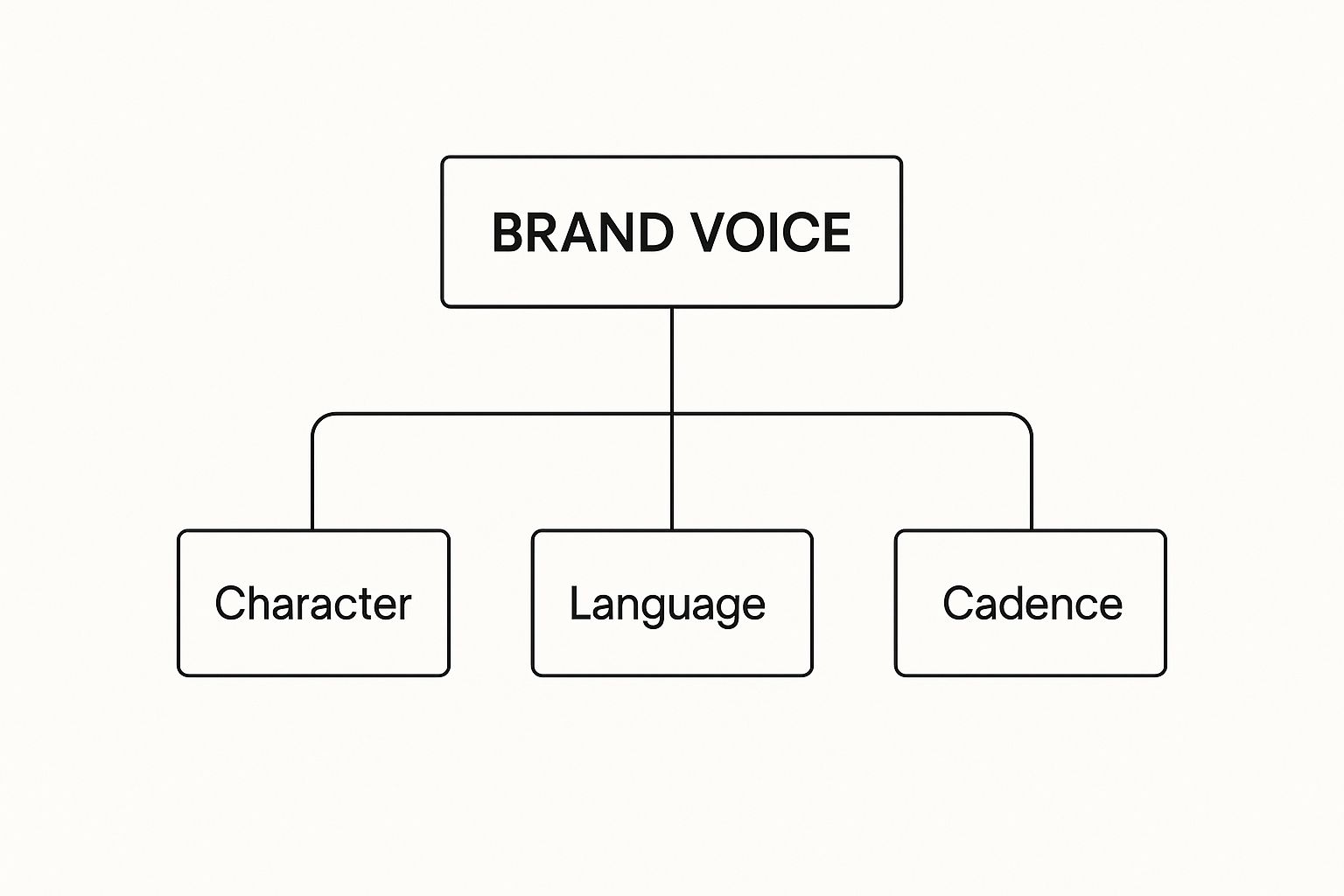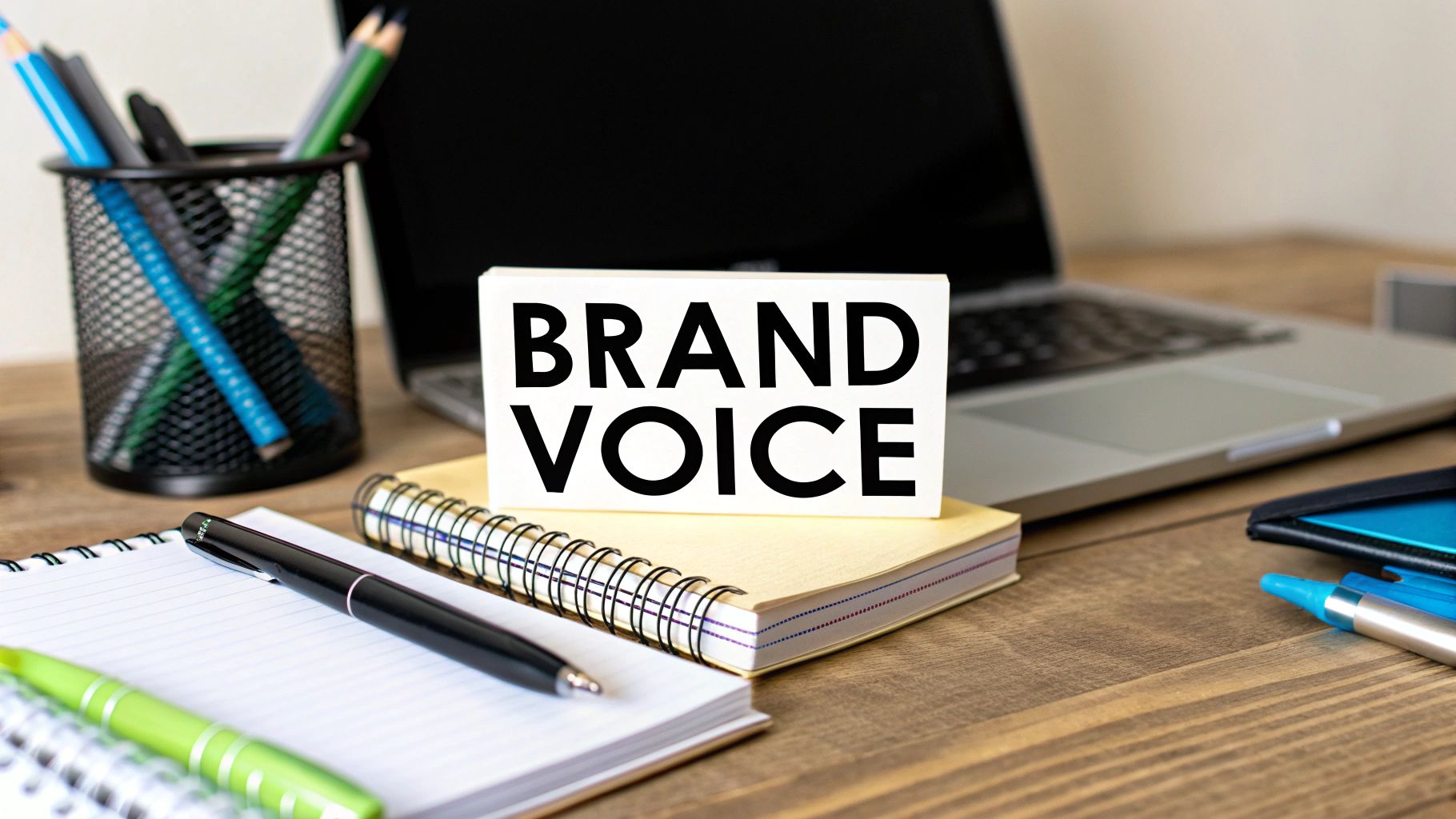Think of your brand's voice as its personality. It’s not just what you say, but how you say it. This is what makes your social media posts, emails, and website copy feel distinct and instantly recognizable, turning a one-way message into a memorable conversation.
What Exactly Is a Brand Voice?

Here’s a simple way to think about it: if your brand were a person, how would they talk? Would they be the witty, energetic life of the party? Or the calm, thoughtful expert sharing deep insights in a quiet corner? That personality is your brand voice.
It’s the human touch that breathes life into your company, making it feel relatable and trustworthy instead of like a faceless corporation.
A clearly defined brand voice is far more than a "nice-to-have" creative detail; it's a core business asset. When every piece of content—from a quick tweet to a long-form report—sounds like it came from the same source, you create a sense of predictability and reliability. That consistency is the bedrock of customer trust.
Why a Consistent Voice Is So Important
In a market overflowing with noise, a distinct voice is one of the best ways to get noticed. It works alongside your logo and colors to shape how people feel about you. Without it, your communication can feel disjointed and confusing, which ultimately weakens your connection with the very people you’re trying to reach.
A strong, consistent voice helps you:
- Build Trust and Recognition: When you always sound like yourself, people start to recognize and trust you. Familiarity breeds comfort.
- Create Deeper Connections: People are drawn to personalities they like and understand. A voice that truly resonates with your audience makes them feel seen.
- Stand Out from the Crowd: Your competitors might sell similar things, but your unique personality is something they can't copy. It’s a powerful way to attract your ideal customers.
A consistent brand voice isn't about robotic repetition. It's about showing up as the same authentic brand in every conversation, building credibility one word at a time.
This isn't just about feelings; it has a real financial impact. Research shows that brands maintaining a consistent voice see revenue increases between 23% and 33%. Why? Because a clear voice builds recognition and trust, which are directly tied to sales. It’s also a crucial piece of the puzzle for building your complete brand messaging.
The Four Elements of a Memorable Brand Voice
The idea of a "brand voice" can feel a little fuzzy and abstract. How do you actually build one? It helps to think of it like a recipe. Just as different ingredients combine to create a unique flavor, a strong brand voice is a mix of four distinct elements.
Once you get a handle on these, you’ll have a clear framework to build your own voice. You'll move from a vague idea of "sounding like us" to a concrete set of guidelines that anyone on your team can actually follow. This is how you get real consistency.
This infographic gives a great visual breakdown of the components that shape your brand's unique communication style.

As you can see, Character, Language, and Cadence are the pillars holding up the entire Brand Voice. Get these right, and you've built something solid and recognizable.
1. Character: The Core Personality
First up is your brand's character—its fundamental persona. If your brand walked into a party, who would it be? This is all about defining the human-like qualities that make you relatable.
Are you the Trusted Mentor, offering wise, steady guidance? Or maybe you're the Witty Sidekick, always ready with a clever joke to lighten the mood. Pinning down this archetype is your most important first step. It sets the foundation for everything else.
For instance, a financial advisory firm would likely adopt the Mentor character to project stability and expertise. A new snack brand, on the other hand, might go for the Sidekick to feel fun and approachable.
2. Language: The Words We Use
Once you know who you are, you can figure out how you talk. Language covers your specific vocabulary, phrasing, and level of formality. It’s the most direct expression of your brand’s personality.
Your word choices have to align perfectly with the character you’ve established.
- Simple vs. Technical: Are you using straightforward, everyday words? Or are you using industry-specific jargon to signal deep expertise?
- Formal vs. Casual: Is your communication buttoned-up and professional, or is it more relaxed and conversational, maybe even using slang or emojis?
A B2B software company talking to engineers will use precise, technical language. In contrast, a fashion brand selling directly to Gen Z will use casual, trendy language to connect with its audience.
Key Takeaway: Your language isn't just about what you say; it’s about making your audience feel like you get them. The right words build a powerful connection.
3. Cadence: The Rhythm of Your Writing
Cadence is the flow, the rhythm, the beat of your sentences. It's subtle, but it has a huge impact on how your content feels to the reader. It sets the pace and energy of everything you write.
Think about music. Some songs are fast and energetic; others are slow and melodic. Your writing has a similar rhythm.
- Quick and Punchy: Short sentences, active verbs, and direct statements create a feeling of urgency and excitement.
- Flowing and Descriptive: Longer, more complex sentences with richer language create a thoughtful, immersive experience.
This rhythm should always match your character. A high-energy fitness brand would naturally use a quick, punchy cadence. A luxury travel company? They'd likely opt for a more flowing, descriptive style to paint a vivid, aspirational picture.
4. Attitude: The Underlying Outlook
Finally, attitude is your brand’s point of view on the world. It’s the underlying emotion that colors all your communication. Your tone might change from a celebratory tweet to a serious support email, but your core attitude should remain constant.
Is your brand inherently optimistic and encouraging? Or is it more authoritative and direct? Your attitude shapes how your audience perceives your values and intentions. It’s the consistent perspective that shines through no matter what you're writing.
How to Define Your Unique Brand Voice

Finding your brand voice isn’t about making something up out of thin air. It’s more of an archaeological dig. You’re uncovering the personality that’s already baked into your company's DNA and figuring out how to let it shine through consistently.
The real goal here is to turn those big, abstract ideas about your brand into solid, practical rules for how you communicate. A genuine voice feels right because it’s built on your brand’s truth, and that authenticity is what creates a powerful bond with your customers.
In fact, a recent report found that 76% of people prefer buying from brands they feel connected to. That connection starts when your voice reflects who you really are.
Start with Your Core Mission and Values
Your brand voice needs a strong anchor, and that anchor is your company's purpose. Before you can figure out how to say something, you have to be rock-solid on what you stand for.
Start by asking the big, foundational questions:
- Why do we exist? Think beyond just making money. What problem are you genuinely trying to solve? What dent do you want to put in the universe?
- What are our non-negotiable values? Try to lock in 3-5 core principles that guide everything you do, from product development to customer service. These are the pillars of your brand’s character.
- What makes us different? Get specific. Is it your unique process, your philosophy on the industry, or your unwavering commitment to a certain outcome?
The answers to these questions are the building blocks of your brand's personality. If you want to dig deeper, using something like a brand questionnaire template can really help structure this discovery process. You can find some great ideas here: https://www.softriver.co/blog/top-brand-questionnaire-template-ideas-to-define-your-brand
Understand Who You Are Talking To
Once you’ve looked inward, it’s time to look out. A conversation is a two-way street, and you can’t have a good one if you don’t know who you’re talking to.
Your voice has to resonate with the people you’re trying to reach. That means getting a real feel for their world, their struggles, and the way they talk.
- Who is your ideal customer? Go beyond demographics and build a detailed persona. What are their goals? What keeps them up at night?
- Where do they hang out online? Pay attention to the language they use on social media, in forums, or on review sites.
- What kind of content gets their attention? Are they into quick, witty videos or do they prefer deep, data-backed articles?
When you truly get your audience, you can choose the right words and tone to make them feel seen and understood. Your voice should sound like a familiar, trusted friend.
Use a "This, Not That" Chart to Get Specific
Abstract concepts like "friendly" or "professional" are fine starting points, but they aren't very useful in the real world. To make your voice truly actionable, the "This, Not That" chart is your best friend. This simple exercise forces you to draw clear lines in the sand.
A "This, Not That" chart is a game-changer because it defines your brand voice by what it is and, just as importantly, by what it is not. It cuts through the ambiguity and gives your team clear guardrails to work with.
This process is a core part of creating any good style guide. Looking at a few branding guidelines examples can give you a ton of inspiration for how to structure your own.
Here's a simple template to help you get started on your own chart.
Brand Voice 'This Not That' Exercise Template
This chart quickly becomes the go-to reference for your whole team, making sure everyone from marketing to customer support is on the same page and speaking with one, consistent voice.
Learning from Great Brand Voice Examples
https://www.youtube.com/embed/yI6aoRY0X-Q
Theory is one thing, but seeing a powerful brand voice out in the wild is when it all really clicks. The best brands don’t just have a voice; they use it with incredible precision everywhere they show up, from a massive Super Bowl ad right down to a single tweet. Their personality feels so authentic that it’s easy to forget it’s a carefully crafted strategy.
Let's dig into how some of the masters pull this off. We'll use the four elements we’ve talked about—character, language, cadence, and attitude—to see how they all work together to build an identity you can’t forget.
Mailchimp: The Supportive Expert
Mailchimp has absolutely nailed the art of being a helpful, approachable guide. Their voice is specifically designed to empower small business owners who might feel overwhelmed by the world of marketing tech.
- Character: They're the knowledgeable friend who’s always in your corner, cheering on your wins.
- Language: Everything is simple, clear, and free of jargon. They stick to words like "grow," "build," and "connect," making complicated concepts feel totally manageable.
- Cadence: The rhythm is calm and steady. Sentences are often short and to the point, creating a reassuring flow that never feels frantic or confusing.
- Attitude: Consistently encouraging and optimistic. All their content is framed around what you can do, making you feel capable and confident.
By sidestepping overly technical language and keeping things positive, Mailchimp builds a ton of trust. Every piece of content quietly says, "We're here to help you succeed."
Wendy's: The Witty Challenger
Everyone knows Wendy's for its bold, playful, and sometimes downright savage social media game. Their voice is a masterclass in knowing your audience and being brave enough to have a little fun.
- Character: The witty, confident friend who’s always ready with a clever comeback.
- Language: Super casual, direct, and packed with modern slang and pop culture references. They speak the language of the internet fluently.
- Cadence: Fast and punchy. Their short, sharp tweets are built for maximum impact and getting shared.
- Attitude: Playful, funny, and unapologetically bold. They aren’t afraid to poke fun at competitors or jump right into conversations with fans.
This one-of-a-kind voice has turned Wendy’s into a cultural icon online. It’s the perfect example of how a strong personality can make a classic brand feel completely current. To see how a unique voice can shape a brand's entire narrative, check out these iconic brand story examples.
A well-defined voice isn't just about sounding cool—it directly impacts the bottom line. Data shows that a personalized voice can boost engagement by 22%, and using clear, action-focused language can lift conversion rates by 14%. It's a real driver of business growth.
Nike: The Inspiring Coach
Nike's voice is pure motivation. It’s engineered to spark action and push people to find their personal best, bringing their "Just Do It" philosophy to life in every single word.
- Character: The intense, inspiring coach who sees the potential you don’t even see in yourself yet.
- Language: Powerful, emotional, and direct. They use strong verbs and aspirational phrases that speak to the inner athlete in all of us.
- Cadence: Rhythmic and impactful. Nike often uses short, declarative sentences that build on each other, almost like a pre-game speech.
- Attitude: Passionate, determined, and laser-focused. The tone is serious about achieving greatness but still manages to feel accessible to everyone.
By consistently showing up as the ultimate motivator, Nike has created a voice that’s bigger than just advertising. It's become a genuine source of inspiration for millions, cementing its legacy as a true leader.
How to Implement and Maintain Your Brand Voice

Defining your brand voice is a huge win, but let's be honest—the real work starts now. The next challenge is weaving that personality into every single thing your company says and does.
Without a clear plan to roll it out, even the most brilliant brand voice will get lost in a sea of inconsistent messages. The key isn't just creating rules; it's about building simple systems that make it easy for everyone to stay on brand. Your goal is to make your voice so intuitive it becomes second nature for the whole team, from marketing to customer support.
Create a Simple Brand Voice Style Guide
Think of a brand voice style guide as your single source of truth. It’s a practical document that turns your abstract voice concepts into concrete rules and real-world examples.
The best guides are simple, visual, and easy for anyone to pick up and use. Forget about those 50-page PDFs that gather digital dust. You’re aiming for a clear, scannable resource that people actually want to use.
Your style guide should include:
- A "This, Not That" Chart: This is the heart of your guide. It provides clear, side-by-side comparisons of what sounds like you versus what doesn't.
- Key Vocabulary: List specific words and phrases to use often, along with a "words to avoid" list to steer clear of common missteps.
- Real-World Examples: Show, don't just tell. Include snippets of how the voice looks in an email, a social media post, and a website headline.
This document doesn't need to be complicated. In fact, a simple guide is often the most powerful tool for keeping things consistent over the long haul. To get started, check out our easy guide on how to create brand guidelines that your team will actually use.
Train Your Team and Get Everyone Onboard
Your brand voice is a team sport. It’s not just for the marketing folks; it needs to be understood and embraced by everyone who talks to customers. Consistency across all departments is what builds that deep, unshakable trust.
Kick things off with a few short, focused training sessions. Walk your team through the style guide, but more importantly, explain the why behind the voice. Use interactive exercises and role-playing with real customer scenarios to help them practice.
Your brand voice style guide is more than a rulebook; it's a tool for empowerment. When everyone on your team understands how to communicate on-brand, they can act with more confidence and autonomy.
Make the guide impossible to miss. Put it in a shared company drive, a Slack channel, or your internal wiki. Encourage questions and create a feedback loop so you can refine the guide over time. When everyone feels a sense of ownership, your brand voice will finally come to life.
Answering Your Brand Voice FAQs
Once you’ve started to define your brand voice, a few common questions always seem to pop up. Getting these sorted out early will save you a ton of headaches and help keep your voice consistent as you grow.
Let’s dig into the most frequent ones.
Can Our Brand Voice Change Over Time?
Absolutely. In fact, it should. Think of your brand like a person—it grows, matures, and adapts. Your brand voice isn't meant to be frozen in time.
The trick is to be deliberate about it. A major rebrand, a shift in strategy, or even just reaching a new level of maturity as a company are all perfect moments to revisit your voice. The goal isn’t to wake up with a totally new personality, but to consciously evolve so you always sound like the company you are today.
How Do We Know If Our Voice Is Actually Working?
This is a great question. You can’t just look at a single metric on a dashboard. Measuring your voice is more about connecting a few dots to see if you’re genuinely connecting with people.
Here’s what I recommend keeping an eye on:
- Audience Engagement: Are people actually responding to what you're putting out there? Look for more than just likes. Are they commenting, sharing, and using similar language or emojis back at you? That's a huge tell.
- Website Metrics: Check out things like time on page and bounce rate for your most important content. A compelling voice grabs people and holds their attention, which means they'll stick around longer.
- Customer Feedback: This one is gold. Read your reviews, surveys, and support emails. When you start hearing customers use the same words and phrases you do to describe their experience, you know you've nailed it.
A great brand voice doesn't just talk at people; it starts a conversation. The real proof it's working is when your audience starts talking your language right back to you.
We’re Starting from Scratch. What’s the Absolute First Thing We Should Do?
If you’re building your voice from the ground up, the first step has nothing to do with writing. It's about looking inward. Before you even think about your customers or what your competitors are doing, you need to be brutally honest about who you are.
Get your team together and hammer out the answers to these three questions:
- Why do we even exist? (What's our purpose beyond making money?)
- What are the 3-5 core beliefs we'd stick to no matter what?
- What's our unique take on this industry? What do we see differently?
This is the bedrock of your brand’s personality. Every single word you choose, every joke you make, and every post you write will grow from these core truths. Whatever you do, don't rush this part.
Ready to build a brand identity that truly stands out? The expert designers at Softriver create custom logos and full brand guidelines that bring your unique voice to life. Get a professional, market-aligned brand identity in as little as 48 hours.







